
Tell us what you need to find a matching loft conversion specialist

Get free quotes from professionals near you

Compare offers and choose the one that best matches your need
- Householdquotes.co.uk
- Home Insulation
- Loft Insulation
Loft Insulation: The Ultimate Guide, Benefits and Tips for 2025

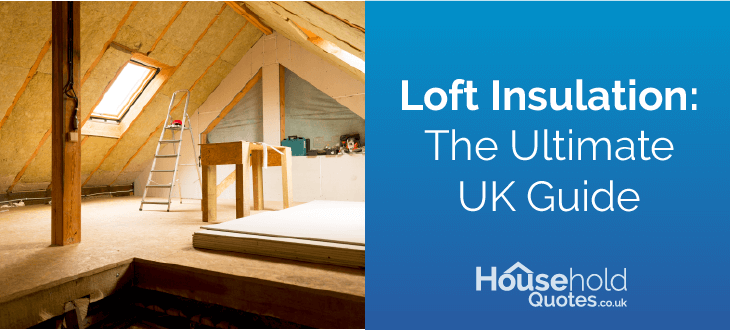
- A 3-bedroom semi-detached house in the UK can insulate its loft for about £930.
- Loft insulation in a 3-bedroom semi-detached house can bring energy bill savings up to £270 each year.
- The investment-to-payback ratio of loft insulation is just 3 years.
Over a quarter of the heat produced in a home is prone to escaping through drafty uninsulated lofts. This is seen in staggering energy bills as heating systems in uninsulated homes constantly battle to keep the internal temperature stable.
Loft insulation stands as one of the most valued and effective upgrades any homeowner could invest in. With affordable costs, impressive savings, and a speedy payback period, your home can benefit from up to 40 years of effective insulation off a single insulation job.
This ultimate guide will walk you through all you need to know about insulating your loft, including the costs, savings, insulation materials, and government grants.
Ready to get your loft insulated? Look no further than Household Quotes UK to land the best bargain. To save you countless hours of research and vetting, access our network of trusted professional installers right in your area by filling out our 30-second form. In return, receive up to 3 free quotes tailored to your home needs, completely free of charges and obligations. Click below to begin!
- Describe your needs
- Get free quotes
- Choose the best offer
It only takes 30 seconds



What is loft insulation?
Loft insulation involves installing a barrier of insulating material in your loft space. This barrier acts to minimise heat loss and reduce temperature fluctuations in your home that cause your heating system to overwork.
While most lofts in the UK already have some degree of insulation, roughly 20% of homes have no loft insulation in place at all. Current building regulations in the UK recommend a minimum 270mm depth of insulation, but some insulated homes might even fall short of this thickness.
Luckily, if dry and in good shape, existing insulation can be topped up for a fraction of the costs compared to starting from scratch.
Benefits of insulating your loft
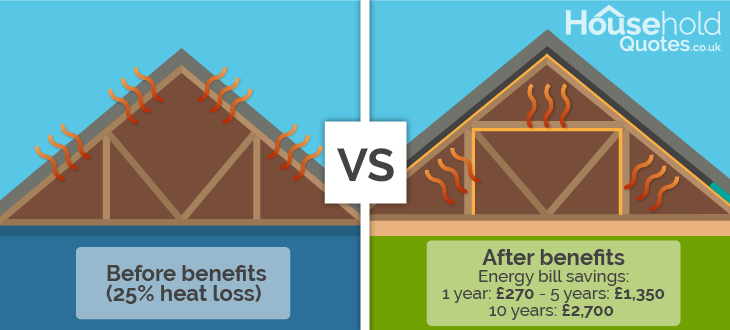
Loft insulation truly stands out as one of the most cost-effective insulation upgrades a home could get. By reducing up to 25% of the heat loss your home experiences, you could expect to enjoy a wealth of benefits such as:
- Bigger savings: Depending on your property size and type, you could potentially be saving up to £270 for a semi-detached home, and up to £445 for a detached home each year on energy bills.
- Decreased CO2 footprint: UK homes are notoriously energy inefficient. Proper loft insulation can help reduce your carbon footprint by 0.5 to 1 ton of CO2 each year! If that sounds like a lot, it’s because it certainly is.
- Higher property value: Each home has an Energy Performance Certificate (EPC) rating. Homes with loft insulation are rated much more favourably, making your property more attractive to potential buyers in the future.
How much can you save by insulating your loft
Based on a typical UK 3-bedroom semi-detached house, loft insulation can save you up to £270 on annual energy bills. However, the exact amount of savings you could expect depends on your property type, existing insulation, and several other factors discussed later in the article.
For a better picture of expected savings, here is our summary of expected savings per home type and insulation thickness in England, Scotland, and Wales:
| Home type | Yearly savings (0mm - 270mm insulation) | Yearly savings (120mm - 270mm insulation) |
|---|---|---|
| Detached home | £445 | £40 |
| Semi-detached home | £270 | £25 |
| Mid terrace home | £240 | £25 |
| Detached bungalow | £440 | £40 |
Expected savings can differ slightly if you are based in Northern Ireland, here is what to expect:
| Home type | Yearly savings (0mm - 270mm insulation) | Yearly savings (120mm - 270mm insulation) |
|---|---|---|
| Detached home | £475 | £45 |
| Semi-detached home | £285 | £25 |
| Mid terrace home | £255 | £25 |
| Detached bungalow | £465 | £45 |
What you need to consider before the loft insulation
Before diving into a loft insulation project, taking a few steps in advance ensures that the job goes smoothly and your investment delivers the best loft insulation you can get. Here's a guide to loft insulation dos and dont’s to help you navigate the process:
- What’s your loft for?
Whether your loft will be storage or living space has a big impact on how it needs to be insulated. While insulating for storage is a simpler task, loft living spaces require a complex job, and a professional installer. If your loft already has insulation that is dry and in good shape, you might even save money by just topping it up to the recommended 270mm of thickness.
- Any existing problems to solve?
Insulation doesn’t just trap heat, it can trap moisture too. If your loft has issues with draft and dampness, insulation will make this problem much worse, breeding mould and rot and leading to soaring repair costs. Solve these issues with a professional before getting insulation in place.
- Professional or DIY?
While a DIY installation will certainly save you money in the short run, it’s still recommended to work with a professional installer as a faulty job can rack up staggering repair bills in the long run. Professionals ensure high-quality work, meet building regulations set by the government, and can complete the job in a fraction of the time and effort it would take you.
How much does it cost to insulate your loft?
A loft insulation cost for a typical 3-bedroom semi-detached house in the UK can be around £930, though your final investment will depend on your property type, chosen insulation materials, and whether you install with a professional or DIY.
If you’re wondering; how much is loft insulation? Then this section can give you a better idea of what to expect. Here’s our summary of average costs per property type and insulation thickness in England, Scotland, and Wales:
| Home type | Average costs (0mm - 270mm insulation) | Average costs (120mm - 270mm insulation) |
|---|---|---|
| Detached home | £1,200 | £930 |
| Semi-detached home | £930 | £760 |
| Mid terrace home | £880 | £720 |
| Detached bungalow | £1,200 | £940 |
Prices in Northern Ireland can differ slightly, so here’s what you could expect:
| Home type | Average costs (0mm - 270mm insulation) | Average costs (120mm - 270mm insulation) |
|---|---|---|
| Detached home | £1,300 | £1,100 |
| Semi-detached home | £840 | £800 |
| Mid terrace home | £740 | £760 |
| Detached bungalow | £1,700 | £1,600 |
While insulating detached homes in the UK may cost the most, they also do bring the highest savings on your annual energy bills of up to £440 - £445, making them a very worthwhile investment for long-term energy efficiency.
Insulation grants
Making your home more energy-efficient can significantly reduce your energy bills and help the environment, but have you ever wondered; can I get free loft insulation?
Fortunately, UK residents have access to several government-backed schemes offering grants for partial or full loft insulation cost coverage.
If you're curious who is eligible for a loft insulation grant, these schemes target low-income and fuel-poor households, allowing them to improve their homes' energy performance at minimal or no cost. Here's an overview of the currently active options:
The Great British Insulation Scheme (GBIS)
- Active until March 2026: This scheme provides one-off grants for various insulation measures, including a grant for loft insulation. GBIS focuses on assisting a broad range of qualifying households, allowing for a wider impact across the UK.
- Direct application: You can apply directly through the UK government portal for GBIS.
Energy Company Obligation (ECO4)
- Active until March 2026: Unlike The Great British Insulation Scheme, ECO4 places the responsibility on energy providers to offer support to low-income and fuel-poor households. This typically includes various energy efficiency upgrades, from heating system replacement to all sorts of home insulation, including loft insulation.
- Indirect application: You cannot directly apply for ECO4. Instead, contact your energy provider to inquire about your eligibility and the assistance available to you.
Homes qualifying for a loft insulation grant can have the chance for partial cost coverage, or free loft insulation, depending on the results of their home assessment.
Choosing the right loft insulation for your property
Choosing the right loft insulation for your property involves a few key factors we will discuss below. These factors will also impact your overall costs. If your loft is safely accessible with regular joists and rafters, insulating becomes much simpler and even DIY-friendly!
Here are the two main approaches to loft insulation you’ll come across:
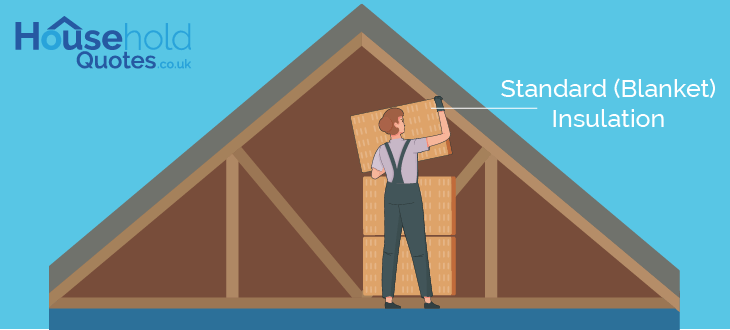
Standard (blanket) insulation is the most popular and cheapest loft insulation for easily accessible lofts and can be purchased as a loft insulation roll. Sheets or batts of insulation material are laid in between and over the floor joists or roof rafters. Common materials used include mineral wool (glass or rock wool), fibreglass, or sheep wool and should ideally be about 270mm to 300mm loft insulation thickness.
- Pros: Easy to install (even DIY), cost-effective, and suitable for most lofts.
- Cons: Not ideal for awkward spaces, may require raising the loft floor for a sufficient depth of 270mm for insulation material, plus a 50mm air gap for ventilation.
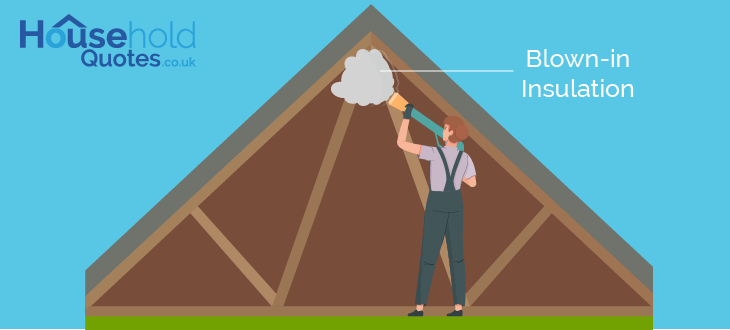
Blown-in insulation is often the solution for unsafe or inaccessible lofts. Professionals use specialised equipment to spray loose insulation fibres throughout the loft space, ensuring coverage even in tricky corners and crevices. Common materials used include cellulose, shredded fibreglass, or mineral wool variants.
- Pros: Excellent coverage for uneven surfaces, ideal for difficult-to-access lofts.
- Cons: Requires professional installation, generally higher cost than blanket insulation.
Choosing the right option will require you to consider a few things:
- Accessibility: Is your loft easily accessible? If not, blown-in insulation is the way to go both from a safety and effectiveness standpoint.
- Budget: Blanket insulation is typically cheaper to obtain and install, but blown-in insulation offers better coverage if your loft is difficult to access.
- Existing Insulation: If your insulation falls short of the recommended thickness, but is dry and in good shape, consider topping up with additional layers or blown-in insulation instead of full replacement. This will be far more affordable.
- Preference: For those who prefer eco-friendly insulators, sheep wool insulation and cellulose are great affordable options. They are also endlessly recyclable and not detrimental to the planet.
It’s recommended to consult with a professional insulation company to assess your loft and the options available to you for your budget. By taking these factors and your specific needs into account, you can choose the ideal loft insulation upgrade for your home, creating a warmer and more energy-efficient home in the long run.
What are the different types of loft insulation?
When it comes to loft insulation, one size doesn't fit all. As mentioned, choosing the best material for your loft will take into account your roof type, budget, and personal needs. Let’s start by taking a look at the popular types of loft insulation and their advantages and disadvantages:

Blanket Insulation: A popular choice due to its ease of installation and affordability. Usually made from materials like mineral wool, fibreglass, loft insulation foil, or sheep's wool, it is installed by being laid in between floor joists and roof rafters.
- Easy to install, even for DIY enthusiasts.
- Versatile and can be cut to size for specific needs.
- Eco-friendly option with recycled wool alternatives.
- Can irritate the skin, requiring protective gear during installation.
- Less effective in odd shapes, crevices, and hard-to-reach areas.
- Loses insulating power when compressed.

Loose-Fill Insulation: A budget-friendly and lightweight option useful for various applications. Normally made from cellulose, mineral wool, or cork in a granular form. It is blown into loft spaces with special equipment to fill drafty gaps and crevices.
- Ideal for odd shapes, crevices, and hard-to-reach areas.
- Excellent solution for topping up existing insulation.
- More eco-friendly and affordable compared to spray foam.
- Can settle and become loose in draughty lofts.
- Requires safety equipment during installation to avoid inhalation and skin irritation.
- Less efficient insulation compared to spray foam loft insulation.

Rigid Board (Sheet) Insulation: A highly effective insulation solution for traditional sloping roofs. Normally made from materials like PIR boards, EPS, or XPS polystyrene, with greener alternatives like cork, straw, and wood. The loft insulation boards are attached directly to the underside of the roof.
- Excellent thermal performance for superior insulation.
- Durable, with some options being flame and melt-resistant.
- Easy to cut and install, suitable for DIY projects.
- Synthetic options are not eco-friendly and have high energy production costs.
- Significantly more expensive than other insulation materials.

Blown-Fibre Insulation: An effective insulation solution that is quick to install, but requires a professional. Made from cellulose, fibreglass, or mineral wool in a loose, fibrous form. It is sprayed into the loft space using specialized equipment.
There is also spray loft insulation, which differs slightly from blown fibre. Normally made from polyurethane (SPF), this expanding foam is sprayed into the loft roof rafters. Nevertheless, it has a very high cost, several safety concerns and is difficult to remove and replace.
- Speedy and convenient installation by a professional.
- Versatile and fills gaps and hard-to-reach areas effectively.
- Lightweight and easy to handle.
- Requires professional installation with specialized equipment, increasing the cost.
- More expensive than other options.
- Not suitable for lofts with draught issues.
How thick should the loft insulation be?
If you're wondering how thick should loft insulation be, the UK government since 2003 has recommended a minimum depth of 270mm for optimal insulation performance.
While this minimum applies to new builds, not all homes meet these needs, especially those that were built before 2003 which likely have 100mm loft insulation. In any case, it's highly beneficial to assess your existing insulation to ensure you're reaping the full energy-saving benefits and reduced heating costs.
If your current insulation falls short of 270mm loft insulation, you have affordable options! Topping up your existing insulation can be a cost-effective solution. This is a handy and affordable option if your current insulation is properly installed and in good condition.
Remember, even a small increase in loft insulation thickness can lead to significant energy savings.
How to insulate a loft
Insulating your loft is a fantastic way to improve your home energy efficiency, potentially saving you £270 to £445 every year on energy bills, recouping your investment within just 3 years.
Before embarking on this project, it is important - as mentioned before - to decide on the purpose of your loft. Whether you plan to use your loft as a storage space or a living space very much determines the type of insulation you need: cold loft insulation or warm loft insulation.
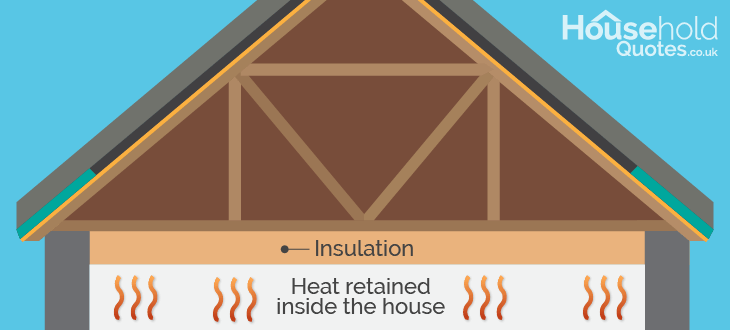
Cold Loft Insulation (Storage):
- This is ideal for lofts used solely for storage, or lofts that are unsafe and hard to access.
- This is when your loft floor is insulated to retain heat in the living area below. It leaves your loft space uninsulated.
Here's how to install cold loft insulation:
- Lift the floorboards.
- Fill the gaps between joists with 270mm of mineral wool insulation.
- Maintain a 50mm air gap between the loft insulation material and floorboards for ventilation.
- If your underfloor lacks sufficient width (which is common), you can elevate the floor using loft legs purchased from a hardware store, or via a professional installer.
While DIY installation for cold loft insulation is possible, consulting a professional ensures proper installation and compliance with regulations.
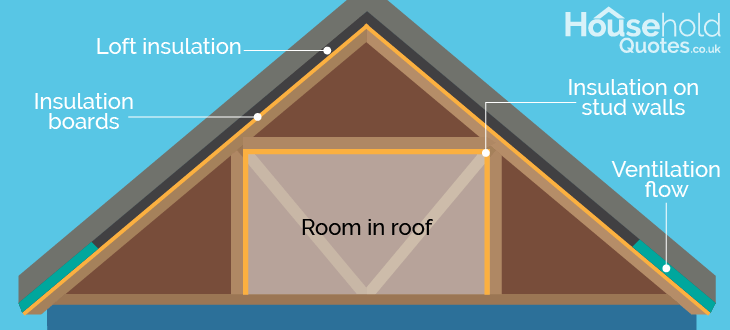
Warm Loft Insulation (Living Space):
- Perfect for lofts planned to be used as living areas.
- This method involves installing insulation between and above the roof rafters from the inside of the loft, followed by plasterboard covering.
- The inner walls of the loft area designated as a living space also require insulation from the rest of the loft. Windows and skylights will require quality glazing and draught-proofing for optimal results.
Warm loft insulation is significantly more complex and should be handled by professional loft insulation installers due to its intricate nature and multiple insulation needs.
Choosing the right loft insulation is only the beginning, as you require the right professional installer to work with. Choosing from a sea of competitors can have you stuck spending hours on web pages and phone calls with no end in sight. Household Quotes UK can save you both time and money by handling the vetting for you!
Simply fill out our 30-second form and receive up to 3 free quotes from trusted installers right in your area, tailored to your specific home needs. No extra charges or obligations apply. Click below to begin!
- Describe your needs
- Get free quotes
- Choose the best offer
It only takes 30 seconds



FAQ
The most common, popular, and cheap loft insulation is blanket or wool loft insulation. Using batts or rolls of mineral wool, fibreglass, or sheep’s wool, insulation is laid in between the joists of the loft floor (cold loft insulation), or in between the rafters of the roof from the inside (warm loft insulation).
Old loft insulation that is dry, undamaged, and within its lifespan does not necessarily need to be removed. Getting a professional assessor to check your insulation can help confirm this. If you have existing healthy insulation in place but fall short of the recommended 270mm thickness, you can simply top up your existing insulation for a fraction of the cost of starting from scratch.
Cold loft insulation is a straightforward task that can be carried out by yourself. It’s important to meet the government-recommended insulation thickness, keep space for healthy ventilation, and use necessary protective gear when handling potentially harmful insulation materials.
In any case, working with a professional insulation installer is highly recommended to make sure that the job is done correctly, and to avoid poor workmanship that can lead to even higher repair costs down the line.
Since 2003, the recommended loft insulation in the UK has been up to 270mm in thickness, normally referring to blanket insulation such as mineral wool, fibreglass, or sheep’s wool. Homes with existing insulation might reduce their costs by simply topping up to the recommended thickness if the insulation in place is in good condition.
Before 2003, 100mm to 200mm loft insulation was standard. However, this is no longer sufficient. New government recommendations suggest up to 270mm of blanket insulation for your loft. This will ensure that your loft is optimally insulated to bring you the best financial and energy efficiency benefits.
The cost of loft insulation for a standard UK 3-bedroom semi-detached home can sit around £930 if you go ahead with blanket insulation. Your final costs can be lower or higher depending on the type of property you have, the insulation material you use, and whether your property already has some insulation installed.
The cheapest way to insulate a loft is to get cold loft insulation. This is when your loft floor is insulated to keep the rest of your house warm. However, your loft area itself will remain uninsulated. This is suitable if you plan to use your loft only for storage purposes.

Akif has a keen interest in green home improvement solutions and the role of digital media in identifying climate trends. He aims to provide a multidisciplinary approach to content rooted in credible research and accuracy.
